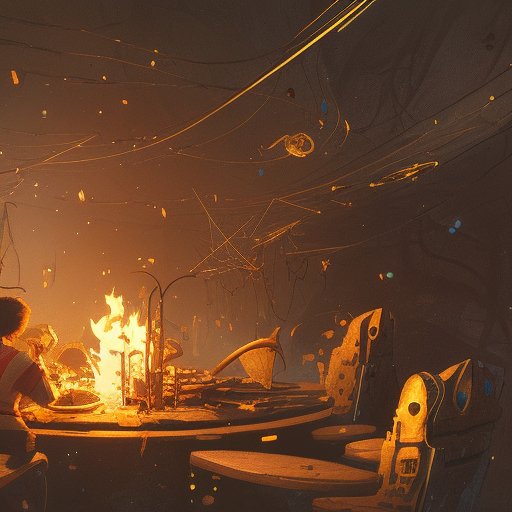
Toxic Yellow Gas – a menace lurking in the outer reaches of the galaxy. This gas, once an obscure scientific curiosity, has become a deadly force to reckon with. In this article, we explore the origins of toxic yellow gas and delve into its properties, effects, and containment measures. We hear from brave survivors who have encountered this gas in the flesh, and we uncover the controversies and conspiracies surrounding its management. The question that remains is whether we can contain this deadly gas and mitigate its effects on our galaxy.
I. Introduction
Welcome, fellow space voyagers, to the perilous and treacherous world of toxic yellow gas lurking in the outer reaches of the galaxy. This deadly, invisible force has wreaked havoc on many brave explorers and spread fear and uncertainty throughout the cosmos. In this article, we will delve into the mysteries of this hazardous gas, explore its origins, and learn about the dangers it poses to all forms of life.

From its humble beginnings in the forgotten corners of the galaxy to its current reputation as one of the most malicious and feared substances in space, toxic yellow gas has long been a subject of intrigue among the scientific community. Probing this enigma has revealed some of the most fascinating and intricate facets of the universe, from the fundamental elements that make up life to the fundamental laws that govern it.
But it has also cast a long shadow over our brave pilots and space miners, who risk their lives every day in the search for resources and knowledge. The effects of toxic yellow gas are swift and merciless, causing respiratory failure, paralysis, and death for anyone unlucky enough to come in contact with it.
However, despite its destructive power, toxic yellow gas remains shrouded in mystery. How is it produced? What makes it so deadly? And most importantly, how can we protect ourselves and our fellow space travelers from its wrath?
These are the questions we will attempt to answer in the following pages. So, buckle up your space helmets and prepare to journey with us into the heart of one of the greatest challenges facing the galaxy today.
II. The History of Toxic Yellow Gas
Toxic yellow gas has been around for as long as humans have been venturing out into the unknown corners of the galaxy. But it wasn’t until the early years of the space exploration era that it began to take on a more ominous reputation.

In the early days, explorers would often encounter small pockets of the gas, and while it was recognized as being lethal, the full extent of its danger was not understood. Many attributed the deaths of explorers to other causes, such as alien life forms or atmospheric conditions.
It wasn’t until a catastrophic incident on a mining colony on the outskirts of the galaxy that the true nature of toxic yellow gas was brought to light. The colony had been experiencing a series of unexplained deaths among its workforce, and eventually, it was determined that toxic yellow gas was the culprit.
The incident sparked widespread fear and panic, and it was soon discovered that the gas was present in larger quantities than previously imagined. As space travel became more common, reports of toxic yellow gas encounters increased, and the substance began to take on its infamous reputation.
Attempts to contain and neutralize the gas were largely unsuccessful, as it proved resistant to most methods of mitigation. Governments and corporations scrambled to develop new technologies to deal with the threat, but it seemed that toxic yellow gas was here to stay.
Over time, the number of fatalities from the gas decreased, as better safety protocols and warning systems were implemented. However, the threat of exposure to toxic yellow gas remains a constant worry for anyone who ventures beyond the safety of home. The legacy of toxic yellow gas is one of fear, uncertainty, and a reminder of the dangers that lurk in the far reaches of space.
III. The Science behind Toxic Yellow Gas
Toxic yellow gas is a formidable foe that has confounded scientists for eons. Its properties are both mysterious and deadly, making it a significant threat to all forms of life in space. This gas is known to be highly corrosive, capable of penetrating even the toughest materials and causing immense damage. Scientists believe that its source lies deep in the heart of the galaxy, where unknown forces combine to produce this perilous substance.

The effects of toxic yellow gas on living organisms are nothing short of catastrophic. Even a tiny amount of this gas can cause significant damage to the lungs and other vital organs. The gas quickly penetrates tissues and disrupts cellular function, causing immediate paralysis and respiratory failure. In severe cases, the gas can lead to death in a matter of minutes.
Because toxic yellow gas is both invisible and odorless, it is impossible to detect without the use of specialized equipment. This makes it extremely challenging to protect oneself against accidental exposure, and it underscores the importance of continuous monitoring and detection systems.
Despite the significant risks posed by this gas, scientists and researchers continue to study its properties and effects in the hope of finding a way to mitigate its impact. The ultimate goal is to identify the underlying mechanisms that enable toxic yellow gas to produce such devastating effects, and to develop strategies to combat this deadly substance.
In a galaxy where danger lurks at every turn, toxic yellow gas represents one of the most potent threats to human existence. But with knowledge and determination, we can work to understand and ultimately overcome this perilous substance, ensuring a brighter future for all who call this vast expanse of space their home.
IV. Tales from the Frontlines
Amidst the dangers of space travel, tales of courage and resilience shine through like stars in the night sky. And in the case of toxic yellow gas, these tales are nothing short of epic.

Take the story of Captain Freya and her faithful crew, who were on a routine mining mission when they encountered a massive cloud of toxic yellow gas. With no warning systems in place, they were forced to rely on their quick wits and ingenuity to survive.
Using their suits’ limited oxygen stores and makeshift filters, they managed to brave the gas and make it back to their ship. But it was only the beginning of their ordeal, as they soon discovered that the gas had infiltrated their ship’s systems, causing critical failures across the board.
For hours, they fought against the gas and the failing equipment, racing against the clock to make repairs before oxygen depletion doomed them all. But in the end, their spirit and determination prevailed, and they emerged victorious against all odds.
Or how about the case of the Frontier Expeditionary Force, who found themselves stranded on an alien planet with a dense and deadly cloud of toxic yellow gas covering the entire surface? With no hope of rescue, they had to adapt to their harsh new environment, learning to live off the land and scavenge for resources.
Through sheer grit and determination, they built a thriving colony in the midst of the gas, developing new technologies and techniques to counter its effects. And when the day finally came that they were able to contact the outside world and tell their story, they had become legends in their own time.
These stories and many more like them inspire us all to defy the odds and overcome the challenges of the universe. So, let us all take heart and press on, for who knows what adventures and tales await us in the bravest frontier of all.
V. Controversies and Conspiracies
However, the dangers posed by toxic yellow gas extend beyond physical harm to human beings. There are also political and economic ramifications that have plunged governments and corporations into turmoil. Many companies have been accused of exploiting the gas for their own gain, exposing workers to the deadly substance and disregarding safety protocols. These allegations have sparked bitter public backlash, and many advocates have called for strict regulations and accountability measures to be put in place.

At the same time, some voices have suggested that governments themselves may be complicit in cultivating the production of the gas, harboring secret research facilities and carrying out covert experiments on human subjects. These theories have stirred up a hornet’s nest of secrecy and suspicion, creating a climate of fear and mistrust among those who seek to uncover the truth.
Amidst this confusion, it remains clear that toxic yellow gas poses not only an immediate threat to the lives and well-being of space travelers but also a long-term challenge to the very fabric of society. The need for transparency and honest dialogue has never been more pressing, as we strive to create a safer and more equitable future for all beings in the galaxy.
VI. Where do We Go from Here
Now that we know the dangers of toxic yellow gas, what can we do to prevent its spread? First, we need to increase our awareness of where it might exist, especially in uncharted regions of space. This can be achieved through the deployment of specialized probes and sensors that are designed to identify and measure the presence of toxic yellow gas.

Once detected, the best course of action is to isolate the affected area, both physically and electronically, to prevent the gas from spreading to other parts of the ship or station. This may involve shutting down ventilation and life support systems or sealing off compartments until the gas can be safely removed.
Another potential solution is the use of specialized coatings or barriers that can filter or neutralize the gas, preventing it from harming human occupants or sensitive equipment. However, these measures are still in the experimental stages and require further research before they can be implemented widely.
In addition to these technological solutions, it is also important to establish clear protocols and procedures for handling and responding to the threat of toxic yellow gas. This includes training all crew members in how to detect and respond to gas leaks, as well as implementing regular safety checks and drills to ensure everyone is prepared for emergencies.
Ultimately, the key to mitigating and containing the spread of toxic yellow gas is a combination of vigilance, preparation, and technological innovation. With these tools at our disposal, we can continue to explore the outer reaches of the galaxy with confidence and courage.
VII. Conclusion
As we come to the end of our journey through the treacherous world of toxic yellow gas, we can take comfort in the knowledge that we are better equipped to face this deadly threat than ever before. From the brave pilots who have risked their lives to study its properties to the scientists who have devoted their lives to developing new technologies and strategies to combat it, we have made great strides in taming this formidable adversary.

But there is still much work to be done. As the galaxy continues to expand and the demand for resources grows, the threat of toxic yellow gas looms ever larger. It is up to all of us to remain vigilant, to stay informed, and to work together to find new ways to prevent its spread and protect ourselves from its deadly effects.
From new methods of ventilation to advanced filtering systems, from specialized suits and respirators to cutting-edge sensors and detectors, we must continue to invest in the tools and technologies that will help us navigate this danger-filled universe. We must also remain vigilant against those who would profit from its spread and work tirelessly to expose the hidden threats that lurk beneath the surface.
At the same time, we must not forget the human toll that toxic yellow gas has taken on our fellow spacefarers. We must honor the memory of those who have lost their lives and work tirelessly to ensure that their sacrifices were not in vain. Only by taking a stand against this merciless enemy can we ensure that future generations will be able to explore the stars in safety and hope.
So let us work together, brave explorers and daring adventurers, to build a brighter future for all who call the galaxy home. Together, we can overcome even the deadliest challenges and continue to expand the boundaries of our knowledge and our imagination.






